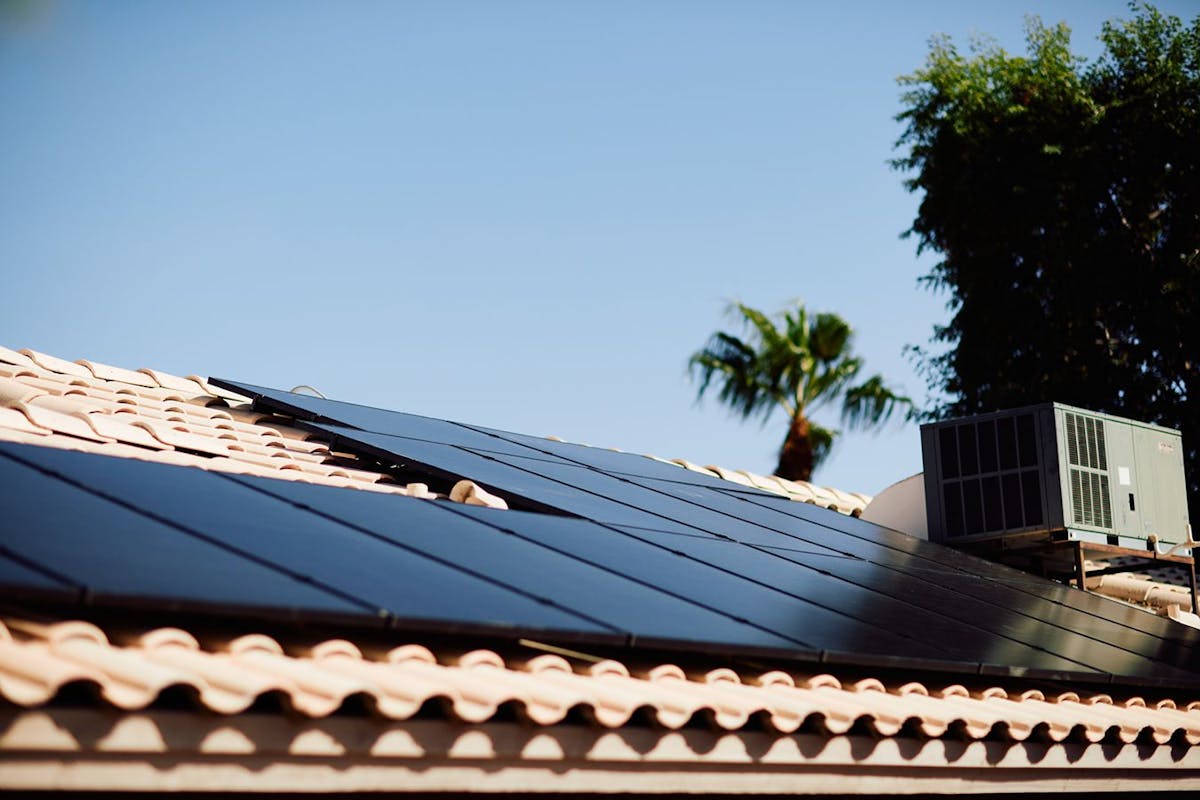Home Battery Backup Guide: Cost, Benefits, and Capabilities
Last edited

Author
Andrew Blok
Electrification and Solar Writer and Editor

Editor
Ryan Barnett
SVP, Policy & New Market Development

Millions of homeowners have installed home solar panels, and an increasing percentage are including batteries.
Home batteries come with a load of benefits, from energy resilience during an outage to maximizing clean energy use to unlocking greater solar savings. But not every home is a good fit for battery storage. Here's what you need to know about the increasingly popular technology.
See how much you can save by going solar with Palmetto
Home Battery Backups in 2025
Home battery backups are being paired with home solar panels more frequently than ever before. This momentum is largely due to diminishing product costs, and battery prices are expected to continue falling through the end of the decade, according to research from the National Renewable Energy Laboratory.
In the US, 14% of new solar systems had energy storage backup included in 2023. In 2024, 28% of installations included a battery, exceeding the 25% predicted in research by Wood Mackenzie.

Download the free Palmetto app and start earning rewards toward a $1,000 discount on a home battery when you save energy at home.
How Do Home Battery Backups Work?
A home battery backup can operate in several different ways, depending on whether or not you have solar panels and if your property is connected to the energy grid.
- Solar panels with backup batteries: Batteries can be charged with solar power during the day and then discharged to your home at night to limit your property's consumption of grid electricity. If your battery is fully charged and your solar panels are still producing electricity, the excess power will be sent to the grid and usually redeemed as an energy bill credit.
- Off-grid solar batteries: If your home is not connected to the utility grid, a battery backup is the only way to capture all of the electricity your panels produce throughout the day. Therefore, batteries are required for sustained access to electricity from solar power in remote locations and mobile homes.
- Standalone home batteries: Even without solar, some homeowners find installing battery backups may be worth it to store electricity in case of a grid power outage. Batteries can be used both as an alternative to and in conjunction with other home energy generators.
Today’s home batteries give users full control over their energy storage and usage. Most home solar batteries are app-integrated, with intuitive monitoring and management controls that include several automated operating modes to help meet your energy goals.
The Benefits of Solar Panels With Home Battery Backups
As a homeowner, there are many financial, environmental, and lifestyle benefits of a solar and battery storage installation.
Backup power during electric grid outages
Without a battery, grid-tied solar panels shut down to protect the equipment and workers repairing damaged power lines. By adding battery storage to solar panels, you can island, or temporarily go off-grid, to run your critical devices with the energy stored in your sustainable renewable power system.
Solar power systems with backup storage give you highly dependable power in emergency situations. In 2022, a Lawrence Berkeley National Laboratory study found battery backup with solar could be reliable in most areas of the US for most times of the year during a long-term grid outage.
Researchers found solar panels and energy storage would work to power the essentials (refrigeration, interior lighting, a few plugs, and well pumps) for a majority of homes affected by a lengthy power outage. Specifically, they found a 10kWh battery paired with solar could get virtually all homes through a three-day outage, if that home didn’t need its heating or cooling. The same storage size met 86% of the power load for three days if using heating and cooling.
The study found a 30kWh storage capacity could meet 96% of the power load during a 3-day outage, including heating and cooling.
Just as critical, the study showed backup power remains effective through longer spans. In most circumstances, solar panels will recharge the battery. Therefore, with the 30kWh storage, the batteries could meet 92% of a home’s power load at day 10 of an outage.
Percentage of home power covered by battery backup in an outage
| Battery storage capacity | 1-day outage (with heating and cooling) | 3 days (without heating and cooling) | 3 days (with heating and cooling) | 10 days (with heating and cooling) |
|---|---|---|---|---|
| 10 kWh | Not in study | 100% | 86% | Not in study |
| 30 kWh | 98% | 100% | 96% | 92% |
Greater energy independence
With a home battery backup, you can tap into your stored solar power any time you want, unlocking several benefits beyond preparedness for grid outages. By consuming more of the solar power you generate directly onsite and offsetting ongoing grid electricity purchases, you’re reducing your reliance on your utility.
More emission-free electricity at home
In 2023, 60% of utility-scale electricity in the US was generated by natural gas, coal, or another fossil fuel. Meanwhile, solar energy accounted for just under 4% of total electricity generation. A battery can help you avoid dirty grid energy and consume more carbon-free electricity at home.

Image source: SolarEdge
Expanded solar energy savings
In areas with time-of-use electricity rates, a home battery backup enables smarter utility energy purchases. For example, let’s say your utility charges 30 cents per kWh during peak billing hours (from 3-7 p.m.), and 10 cents per kWh throughout the rest of the day. If you need to run your dishwasher, EV charger, or another high-energy-demand appliance during peak hours, you can avoid paying premium prices by discharging your stored solar power.
In areas without 1-to-1 net metering policies, like the net billing rates in California, Arizona, and Illinois, energy storage and smart consumption habits can also help you recover the costs of going solar more quickly than systems without a home battery.
Typical payback periods for residential solar in California were 5-7 years. Under the new net billing program, the average payback period is estimated to be 10.7 years according to Wood Mackenzie in 2022. But the payback period of solar-plus-storage systems could be significantly shorter. Wood Mackenzie calculated a solar-plus-storage system for a Southern California Edison customer could pay for itself in 7.5 years.
Participation in grid-sharing programs
Finally, grid-sharing programs for home battery owners are now in operation and development across many parts of the US. These programs, like the ConnectedSolutions Battery Program in Massachusetts or the Renewable Battery Connect Program in Colorado (closed for the remainer of 2025), pay homeowners directly for discharging stored power to the grid during peak-demand hours.
By tapping into a distributed network of customer resources, grid-sharing programs enable utilities to better balance power supplies throughout the day, while rewarding battery owners for their participation. Although programs vary across the country, participants in ConnectedSolutions with National Grid can earn an average of $1,500 per year in 2024.
Virtual power plants (VPPs) — networks of energy-related devices and equipment working together to reduce demand or supply energy to the grid — are becoming more common in the US. A VPP coordinates devices like batteries, smart home devices, and electric vehicles, to ease stress on the grid at times of peak demand.
See how much you can save by going solar with Palmetto
Home Battery Purchasing Considerations
Deciding which battery backup system you will install is the most crucial step in the purchasing process. The ideal solution for your property will align with your energy goals and budget. To narrow down your search, let’s look at the two main motivators for home battery purchases.
Home energy backup: If you live in an area with semi-frequent grid power interruptions, or simply like to be prepared, a small solar battery can go a long way to keeping critical devices running. A smaller-capacity battery could be enough to power your essentials through a typical outage and come with a lower price tag.
Long-term savings: You might install battery backup to increase your savings from going solar by capturing and using more of your solar energy production or selling it to the grid when it's most valuable. In this case, your ideal battery size could depend on your local cost of electricity and the value of bill credits you could earn.
How Much Does a Home Battery Backup Cost?
According to the National Renewable Energy Laboratory in the first quarter of 2022, the average purchase and installation cost of a residential solar backup battery was $17,139. The price of your solar battery is heavily dependent on the storage capacity you choose, and project expenses can be broken down into the following categories.
- Hardware: In addition to the battery itself, home power backups require balance-of-system (BOS) components, wiring, an inverter, and several small pieces of installation hardware.
- Labor: Battery installations are typically performed in less than a day, and a licensed electrician is usually required for your system to be interconnected to the grid.
- Permitting: Interconnection permits and building inspections will typically add a few hundred dollars to a solar battery installation.
- Overhead: From manufacturers through the supply chain and at the installation level, variable expenses may be incurred in project overhead, marketing costs, and other fees factored into supplier prices.
As they become more common and manufacturing practices get better, battery prices will keep falling.
Cost details for residential storage

Break down of cost for residential storage. Source: National Renewable Energy Laboratory
Financial Incentives for Home Backup Batteries
To reduce the costs of home battery backups, there are many incentives, rebates, and programs available federally and locally for American homeowners. First and foremost, the Residential Clean Energy Credit (RCEC) can be claimed for up to 30% of total project costs on battery storage, solar panels, and several other home upgrades through the end of 2025.
Locally, many states, cities, and utilities also offer one-time rebates for purchasing a home backup battery, with values typically based on the system’s energy storage capacity.
In North Carolina, Duke Energy gives a $5,400 rebate for battery storage, for qualifying lithium-ion batteries up to 13.5 kWh, and a $9,000 total rebate on a solar plus storage system. In California, the California Public Utilities Commission’s Self-Generation Incentive Program gives some customers a rebate of $1,000 per kWh of energy storage installed.
Home Battery Backup Pros and Cons
Each household’s needs and priorities are different, so the specifics of a solar system and energy storage as part of the system are customizable. Batteries can be a valuable addition to a home solar system, but won’t be cost-effective for every home.
Battery backup pros
Extra solar savings: Solar panels let you avoid buying electricity from your utility company, saving you money. In places where net metering credits are lower than the utility electricity rate, batteries can increase your savings by letting you avoid more utility electricity.
Emergency electricity: During an outage, batteries can provide backup electricity to power your essential appliances and devices. Solar panels can refill your battery during an extended outage.
More clean energy: A battery can let you store clean solar power to use at night when the grid’s electricity is often the dirtiest.
VPP participation: Virtual power plants aggregate devices like batteries to provide electricity to the grid when it needs it. Depending on the program, you might be compensated for the electricity you share.
Battery backup cons
Cost: Adding battery storage comes at a cost, but tax credits or rebates at the federal, state and/or local level may be available.
Capacity: Batteries are most likely to be cost-effective if they’re sized to only back up the essentials during an outage. You can install enough batteries to power your entire home but, depending on its size, it’ll cost you.
Is a Home Battery Backup Right for You?
A home battery backup could be worthwhile if you live in an area, or are serviced by a utility company, with frequent outages. It’s also likely to make more sense in states or localities without net metering programs or VPP networks which are more valuable to the individual consumer. On the other hand, areas with rare blackouts or outages and poor or no incentive policies or programs might make home energy storage systems not worth the additional cost.
Depending on how highly you value having power through an outage, backup batteries may be worth the cost.
See what you could save by going solar with Palmetto. Start by estimating your solar savings or download the Palmetto app for fun and easy ways to save energy that can earn you discounts on energy saving devices.
See what solar can do for you:
Battery Backup FAQs
What is the cost of a backup battery for solar?
According to the National Renewable Energy Laboratory in Q1 2022, the average purchase and installation cost of a residential solar backup battery was $17,139. Searching commercial sites gets you a range of about $9,000-$34,000 when including installation costs.
How long will a backup battery last?
A 2017 study from the National Renewable Energy Laboratory found lithium-ion solar batteries have an average lifespan of 7-10 years. Smart usage and maintenance of your system may extend battery life.
Is battery backup necessary for home solar?
No. Battery backup is growing in usage and decreasing in price as the technology improves, but many residential solar users do not have battery or storage as part of their systems. Without your own storage, grid-tied panels can’t produce electricity during outages, as the power generated has nowhere to safely travel when lines are down or in repair.
How long can a backup battery run my home?
A fully-charged 10kWh battery can run 86-100% of a home’s power load for a 72-hour span, according to one study. It depends on how many devices and systems are using power, especially the heating and/or cooling, and if the batteries are being recharged during this period.
What happens if I produce more solar power than I need?
If your home is connected to the grid and you’re located in a net metering area, any excess energy produced goes into the grid, and may earn you credit on your electricity bill. If you have energy storage with your solar power system, any excess energy produced and not immediately used by your household will charge your battery. This allows you to use stored power when energy usage exceeds production. Homeowners not connected to the grid often choose to increase their solar storage capacity to enable uninterrupted power regardless of weather or time of day.
If there is a power outage, will my power go out if I have solar panels?
If you add battery backup to your solar panel system, you’ll have access to backup electricity during an outage. If your solar energy system does not include a home battery, your power will go out in accordance with grid codes and mandatory inverter specifications.
Disclaimer: This content is for educational purposes only. Palmetto does not provide tax, legal, or accounting advice. Please consult your own tax, legal, and accounting advisors.


